
Provocative title? Yes. Potential reality? Also, yes.
Cursive, in its most basic form, is connecting the letters of a word together. The most-used words in cursive nowadays? Our names, namely our signature.
So where do elections come into play?
It’s two-fold — early voting and increased scrutiny on identification in voting.
States, in our United States of America, have dramatically increased the ways their citizens can cast a ballot (apart from going to the booth on a single day). In the 2024 election, there were 80 million mail-in and early in-person votes cast, according to the New York Times.
As of the writing of this article — that’s more than half of all votes! (Very nearly 56%, so far.)
“Fascinating, but still not seeing how script handwriting can turn the balance of power.”
Well put, so here we go.
Early voting, for multiple reasons, invites scrutiny. Fewer polling locations, unsupervised drop boxes, on and on.
The point is, signatures and proper identification are huge components of scrutinizing these ballots.
If a ballot is not counted, due to an error, the individual voter has a certain amount of time (dependent upon state laws) to correct these errors. This process is called “curing” ballots. It’s always been a thing, but was thrust upon the scene in 2020 for obvious reasons (aka, the number of mail-in votes was enormous).
Let’s do a little reasoning together:
In 2024, ballot curing is still a big deal. The term “ballot curing” is trending according to Google, but didn’t start until we were on the cusp of the election.

Hopefully, you see the issue.
Now, let’s quickly cover why it can swing an election. Gen Z was a big factor in 2024. Before we voted as a nation, Columbia Magazine, of Columbia University published an article about how Gen Z could potentially sway the results.
And according to some, there were 41 million eligible voters in Gen Z.
Let’s take another trip to speculation land: If half of them vote, and about half never learned cursive, and only a small percentage don’t have a consistent signature — there’s a potential for millions of votes that need curing.
Enough to swing entire states, not just swing states.
Gen Z = 41 million potential votes in 2024. That number will increase in 2028, yes.
But it also opens up the vote to an entirely new generation. Yep, the earliest members of Gen Alpha (that’s their working title, right now) will be eligible to vote in 2028. (Gen Alpha is generally defined as those born between 2010 and 2025.)
Fun fact, many public schools began abandoning cursive in 2010, when Common Core was adopted as the educational standard for many states. Does that mean even fewer Alphas know cursive?
Hard to say.
California, Kentucky, and other states mandated cursive (by law) in 2024. There’s a bit of a comeback for cursive, but these things can take years.
Yes. Always.
Here at MyCursive, we have developed a few resources and tools. First, we have our alphabet hub, allowing anyone to learn to write cursive letters for free.
We also have a full Cursive Curriculum for teachers (some of which never learned cursive themselves) and parents who want to teach their students cursive.
Finally, we just launched our Cursive Worksheet Generator. It’s the first of its kind. Type your name (or anything else you’d like) and generate a PDF worksheet to practice and make your signature your own.
Can anyone really say definitively? No.
But gotta say we love the idea of the ole John Hancock coming back into prominence. So get patriotic and help Gen Z and Alpha learn to sign their names.

